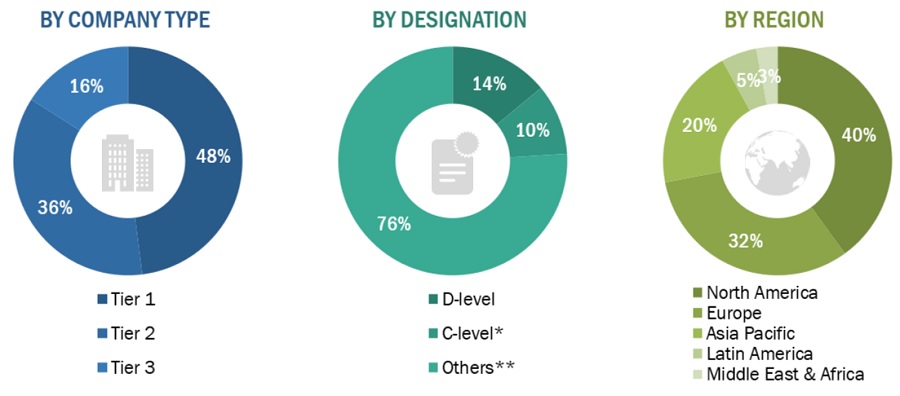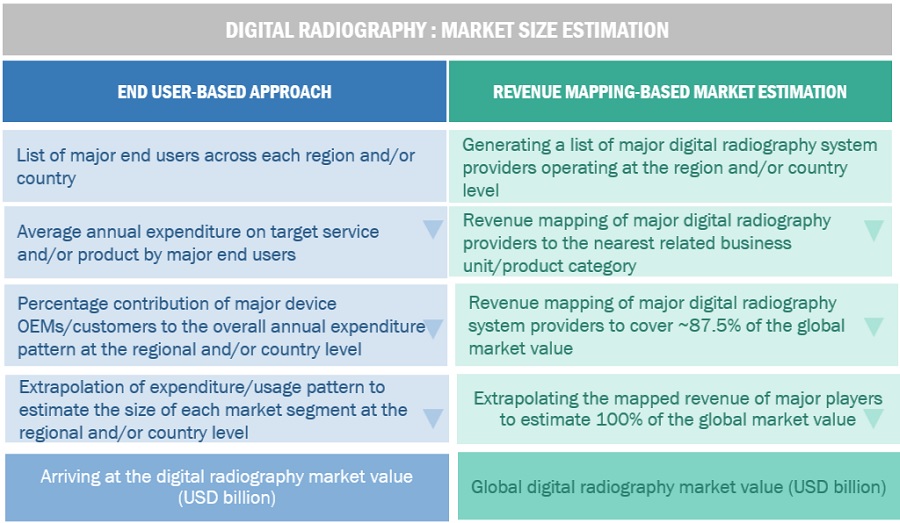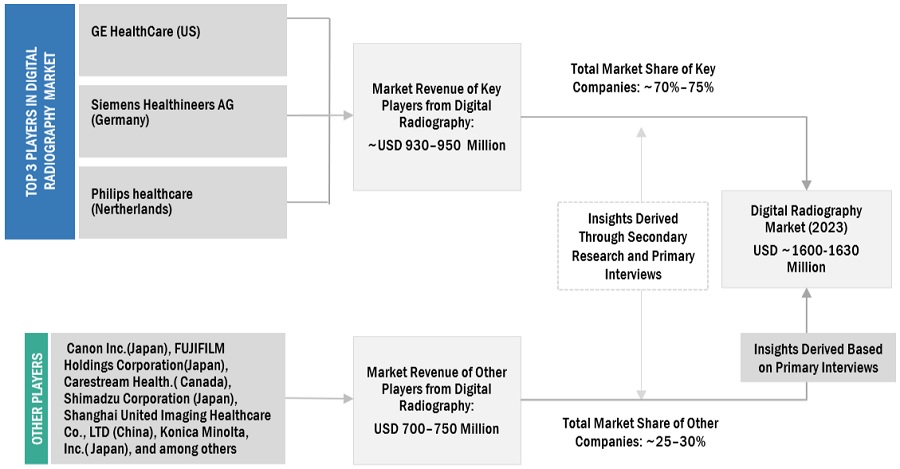Four major activities were involved in the estimation of the current market size of digital radiography. Extensive secondary research was conducted to find data regarding the market, peer markets, and parent markets. Following that, obtained and verified data from about 3-5 secondary documents and different sources; the findings, assumptions, and sizing with industry experts from the total value chain were validated through primary research. Top-down and bottom-up approaches were used to estimate the complete market size. After that, the market size of segments and subsegments was estimated through market breakdown and data triangulation.
Secondary Research
The secondary research process shall make an extended use of the following sources: directories, databases such as Bloomberg Businessweek, Factiva, and D&B Hoovers; white papers; annual reports; company house documents; investor presentations; and SEC filings of companies. The information gathered from the secondary research was used in identifying and collecting data helpful in undertaking an in-depth technical, market-oriented, and commercial study of the digital radiography market. It was also used to derive crucial information of the key players and market classification & segmentation according to industry trends up to the bottom-most level, and key developments related to market and technology perspectives. A database of key industry leaders was also prepared using secondary research.
Primary Research
During the course of this primary research, various sources of supply and demand were consulted to obtain the qualitative and quantitative information required for this report. On the supply side, the primary sources include industry experts like CEOs, vice presidents, marketing and sales directors, technology and innovation directors, and related key executives from various key companies and organizations in the digital radiography market. Primary sources from the demand side include hospitals, orthopedic clinics, diagnostic centers, dental clinics, and other end users. Primary research was conducted to validate the market segmentation, identify key players, and get an idea about key industry trends & key market dynamics.
A breakdown of the primary respondents is provided below:

*Others include sales managers, marketing managers, business development managers, product managers, distributors, and suppliers.
The tiers of the companies are defined based on their total revenue. As of 2022: Tier 1 => USD 1.5 billion, Tier 2 = USD 200-500 million to USD 1 billion, and Tier 3 =< USD 500 million
To know about the assumptions considered for the study, download the pdf brochure
Market Estimation Methodology
In this report, revenue share analysis of leading players has been done to determine the size of the digital radiography market. Identified key players operating in the market have their revenue lined up through their market business. This insight is collected during the primary and secondary research phase. Secondary research includes the study of annual and financial reports of the top market players. On the other hand, primary research included in-depth interviews with key opinion leaders, viz., CEOs, directors, and key marketingexecutives.
Segmental revenues were calculated based on the revenue mapping of major solution/service providers to calculate the global market value.
This process involved the following steps:
-
A list of major players operating in the digital radiography market at the regional/country level
-
Product mapping of various manufacturers for each type of digital radiography product at the regional/country level
-
Mapping of annual revenue generated by listed major players from digital radiography products segments (or the nearest reported business unit/product category)
-
Revenue mapping of major players to cover at least ~87.5% of the global market share as of 2023
-
Extrapolation of the revenue mapping of the listed major players to derive the global market value of the respective segments/subsegments
-
Summation of the market value of all segments/subsegments to arrive at the digital radiography marke

To know about the assumptions considered for the study, Request for Free Sample Report
Bottom-up approach
In this report, the size of the global digital radiography market was determined using the revenue share analysis of leading players. For this purpose, key players in the market were identified, and their revenues from the digital radiography business were determined through various insights gathered during the primary and secondary research phases. Secondary research included the study of the annual and financial reports of the top market players. In contrast, primary research included extensive interviews with key opinion leaders, such as CEOs, directors, and marketing executives.
Approach 1: Company revenue estimation approach
To calculate the digital radiography market value, segmental revenues were calculated based on the revenue mapping of major solution/product providers. The steps involved in this process are as follows:
-
A list of major global players operating in the digital radiography market had to be generated.
-
Mapping of the annual revenues generated by major global players from the digital radiography segment or the nearest reported business unit/product category was done.
-
Mapping the revenues of major players to at least cover 87.5% of the global market share as of 2022
-
Extrapolation of the global value of the digital radiography industry
Market Size Estimation For Digital Radiography : Approach 1 (Company Revenue Estimation)I

Data Triangulation
The overall market size was arrived at after the market size estimation process described in the previous section. Further, the digital radiography market was segmented and subsegmented. The data triangulation and market breakdown procedures were conducted to complete the overall market engineering process and arrive at the exact statistics for all segments and subsegments. The data was triangulated by studying various factors and trends from both the demand and supply sides. Apart from this, the digital radiography market has also been validated using both top-down and bottom-up approaches.
Market Definition
The digital radiography market represents the global market for the development, production, distribution, and sales of radiographic imaging systems that capture images of internal body structures using digital detectors and processing technologies. These replace the old equipment that used film-based radiography to produce images of internal body structures. It caters to a broad spectrum of applications: medical diagnostics, dental imaging, veterinary care, and industrial non-destructive testing follow with the developments in imaging technology, rising adoption within healthcare facilities, and a raising trend toward more effective and accurate diagnostic procedures.
Key Stakeholders
-
Digital radiography system product manufacturers
-
Original equipment manufacturers (OEMs)
-
Suppliers, distributors, and channel partners
-
Healthcare service providers
-
Hospitals and academic medical centers
-
Radiologists
-
Research laboratories
-
Health insurance providers
-
Government bodies/organizations
-
Product distributors and channel partners
-
Hospitals and imaging centers
-
Orthopedic clinics
-
Diagnostic imaging centers
-
Radiologists and Technicians
-
Regulatory agencies
-
Quality control & assurance companies
Objectives of the Study
-
To define, describe, and forecast the digital radiography market based on product, type, application, end user, and region
-
To provide detailed information regarding the major factors influencing the growth of the market (drivers, restraints, opportunities, and challenges)
-
To strategically analyze micro markets with respect to individual growth trends, prospects, and contributions to the total market
-
To analyze opportunities in the market for stakeholders and provide details of the competitive landscape for market leaders
-
To forecast the revenue of the market segments with respect to four regions, namely, North America, Europe, the Asia Pacific, Latin America, Middle East and Africa
-
To profile the key players and comprehensively analyze their market ranking and core competencies
-
To benchmark players within the market using a proprietary competitive leadership mapping framework, which analyzes market players on various parameters within the broad categories of market share and product footprint
Available Customizations
With the given market data, MarketsandMarkets offers customizations per the company’s specific needs. The following customization options are available for the present global digital radiography market report:
Product Analysis
-
Product matrix, which gives a detailed comparison of the product portfolios of the top five companies
Company Information
-
Detailed analysis and profiling of additional market players (up to five)
Geographic Analysis
-
Further breakdown of the Rest of Europe digital radiography market into Russia, Belgium, the Netherlands, Switzerland, Austria, Finland, Sweden, Poland, and Portugal, among others
-
Further breakdown of the Rest of Asia Pacific digital radiography market into Singapore, Taiwan, New Zealand, Philippines, Malaysia, and other APAC countries
-
Further breakdown of the Rest of Latin America (RoLATAM), which comprises Argentina, Chile, Peru, Colombia, and Cuba
-
Further breakdown of the RoW market into Latin America and MEA regions



Growth opportunities and latent adjacency in Digital Radiography Market